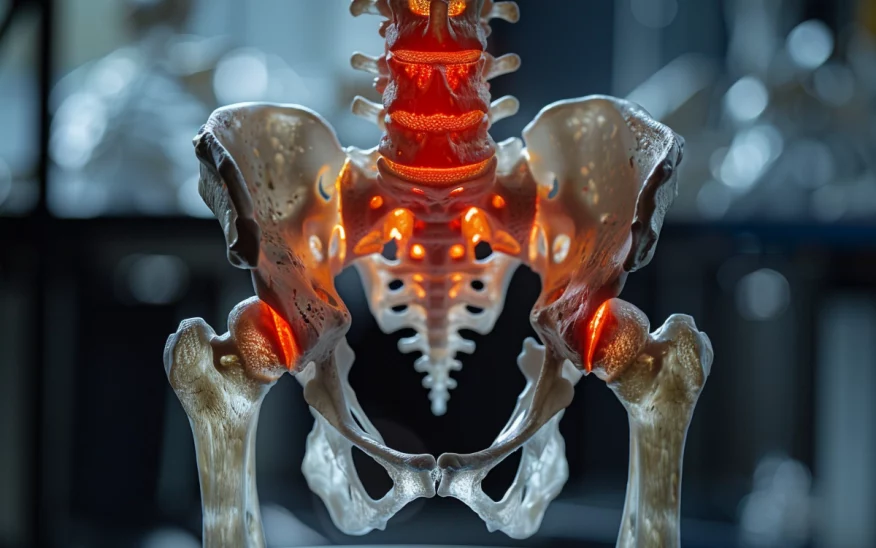Sacroiliac joint pain is a condition that manifests as discomfort in the lower back and buttocks region, where the sacroiliac joints are located. These joints are crucial as they connect the lower spine to the pelvis and support the weight of the upper body when standing and walking. The pain can vary from a mild ache to severe discomfort and may be accompanied by stiffness and reduced range of motion. Factors such as arthritis, injury, pregnancy, or infection can contribute to the development of this condition, affecting daily activities and quality of life.
The proper diagnosis of sacroiliac joint pain involves a thorough clinical evaluation, which may include imaging tests or diagnostic injections to accurately identify the source of the pain. Treatment generally aims to reduce pain and inflammation, improve joint function, and prevent further injury. Options may include physical therapy, medications, or in some cases, surgical intervention. Additionally, incorporating certain lifestyle modifications and home remedies can provide relief and help manage the symptoms associated with sacroiliac joint pain.

Key Takeaways
- Sacroiliac joint pain occurs where the spine meets the pelvis, causing discomfort in the lower back and buttocks.
- A range of treatments is available, focusing on pain relief and improved joint function.
- Incorporating lifestyle changes can aid in managing and relieving pain from sacroiliac joint issues.
Understanding Sacroiliac Joint Pain
Sacroiliac joint pain is a condition that can significantly affect our quality of life. We’ll explore its anatomy, causes, symptoms, and potential risks and complications.
Anatomy of the Sacroiliac Joints
Our body has two sacroiliac joints which link our pelvis to the lower part of our spine, the sacrum. They are critical in transferring weight and forces between our upper body and legs.
Causes of Sacroiliac Joint Pain
Sacroiliac joint pain can stem from various factors. A common cause is joint inflammation or sacroiliitis, which may be linked to arthritis or trauma. Inflammation in these joints can be due to mechanical issues or systemic inflammatory conditions.
Symptoms and Signs
Typically, we might experience a sharp, stabbing pain at the back of the hip or in the lower back when dealing with sacroiliac joint pain. The discomfort may extend down to our legs and is often worsened by prolonged standing or stair climbing.

Risk Factors and Complications
Several factors elevate our risk for developing sacroiliac joint pain, including uneven leg length, previous spine surgery, and pregnancy due to the increased stress on the joints. Unaddressed, this pain can lead to chronic discomfort and mobility issues.
Diagnosing Sacroiliac Joint Pain
When we suspect sacroiliac joint pain, a thorough diagnostic process is essential. We use a combination of detailed medical history, physical examination, and advanced imaging techniques to isolate and identify the source of discomfort.
Medical History and Physical Examination
Understanding a patient’s medical history is the foundation of diagnosing sacroiliac joint pain. We inquire about past incidents, duration, and the nature of the symptoms to establish a pattern that may suggest sacroiliac joint involvement. During the physical examination, specific maneuvers are performed to assess the integrity of the sacroiliac joints and to reveal pain triggers. For instance, we might press on the hips and buttocks or move the legs into different positions to gently stress the sacroiliac joints.
- Provocation tests used include:
- FABER (Flexion, ABduction, and External Rotation)
- Compression
- Gaenslen’s test
Imaging Techniques
Imaging tests are crucial to exclude other causes of pain and to confirm a diagnosis of sacroiliac joint pain. An X-ray of the pelvis may show signs of degeneration or changes in the sacroiliac joints. An MRI is particularly useful as it can provide detailed images of both bone and soft tissue, revealing inflammation or damage associated with sacroiliitis.
- Common imaging tests include:
- X-rays: To check for bone abnormalities
- MRI scans: To visualize inflammation or injury
Diagnostic Injections
Diagnostic injections serve as a dual-purpose tool: they can confirm a diagnosis and also provide temporary relief from pain. By injecting a local anesthetic into the sacroiliac joint, we can observe the patient’s response to the medication. If the pain significantly diminishes after the injection, it confirms that the sacroiliac joint is the pain source, rather than another condition like infection or lumbar spine issues.

- Injection procedure involves:
- Administering a local anesthetic
- Possibly including a corticosteroid for its anti-inflammatory effects
Treatment Options for Sacroiliac Joint Pain
We understand that sacroiliac joint pain can be a significant hindrance in everyday life. Our focus in this section is to explore various treatments that can help alleviate this discomfort, from medications to potentially necessary surgical interventions.
Medications
We often begin with nonsteroidal anti-inflammatory drugs (NSAIDs) to reduce inflammation and pain in the sacroiliac joint. For more severe cases, corticosteroids might be directly injected into the joint to provide relief from swelling and pain.
Physical Therapy and Exercises
Physical therapy is crucial in managing sacroiliac joint pain. It involves tailored exercises to strengthen the muscles around the sacroiliac joint, enhancing joint function and reducing pain. We also teach proper posture and body mechanics to maintain joint alignment and prevent future pain.
Interventional Procedures
When conventional treatments do not provide the desired results, we may recommend interventional procedures like radiofrequency ablation. This process involves destroying nerve fibers that carry pain signals to the brain, offering potential long-term pain relief.
Surgical Approaches
Surgery is usually our last resort, reserved for cases where nonsurgical treatments fail. We may consider minimally invasive surgery to fuse the affected joint or traditional “open” surgery, depending on the specific needs of the case. Surgical options are aimed at stabilizing the joint and providing sustained pain relief.
Lifestyle and Home Remedies

When managing sacroiliac (SI) joint pain, we have several lifestyle and home remedies at our disposal that can significantly contribute to pain relief and improved function. Let’s discuss specific strategies that can be implemented.
Activity Modification
To reduce the strain on our SI joints, we can make practical adjustments to our daily activities. For example, we should avoid movements that exacerbate pain, such as prolonged standing or sitting. When lifting objects, it’s crucial to use our legs, keeping the object close to our body to minimize pressure on the SI joint.
Exercise and Stretching
Incorporating strengthening exercises and stretching can help maintain joint stability and flexibility. Regular, low-impact exercises such as walking or swimming can bolster our muscles without putting undue stress on the joints. Stretching exercises, particularly for the hips and lower back, can alleviate stiffness and improve our range of motion.
- Strengthening Exercises: Pelvic tilts and bridges can fortify the muscles surrounding the SI joint.
- Stretching: Gentle yoga poses or a knees-to-chest stretch may reduce tension in our lower back.
Self-Care Strategies
Lastly, we shouldn’t underestimate the importance of self-care strategies in managing SI joint pain. Applying ice or heat can soothe inflamed joints and relieve pain. Over-the-counter pain relievers can also provide temporary relief, though their use should be judicious to avoid potential side effects. Adequate rest and avoiding actions that trigger pain are fundamental in allowing our joints to heal.

Living with Sacroiliac Joint Pain
Dealing with sacroiliac joint pain can significantly impact our daily lives, presenting challenges that require careful management and coping strategies. We need to consider both the physical and psychological aspects to maintain a good quality of life.
Managing Chronic Pain
Chronic Pain and specifically Lower Back Pain, can persist as a symptom of sacroiliac joint dysfunction. Our management options include:
- Physical Therapy: Tailored exercises strengthen our muscles and improve flexibility.
- Medication: Anti-inflammatory drugs help decrease pain and swelling in the joint.
- Joint Injections: Corticosteroids may be injected directly into the joint to reduce inflammation and pain.
- Minimally Invasive Procedures: These include radiofrequency ablation which targets the nerves to reduce pain signals.
- Surgery: In severe cases, procedures like Joint Fusion may be considered to stabilize the joint and minimize pain.
Psychological Impact
Living with ongoing pain can lead to Depression or feelings of frustration and helplessness. It’s imperative for us to:
- Acknowledge our emotional responses to pain.
- Seek professional counseling if needed.
- Engage in stress reduction techniques like mindfulness or meditation.
Support and Coping
Weighing our Prognosis and exploring support options can promote better coping. Our strategies may involve:
- Support Groups: Connecting with others who understand our experience.
- Education: Learning about our condition empowers us to make informed decisions.
- Engaging in regular, low-impact exercise.
In managing sacroiliac joint pain, we should always consult healthcare professionals to personalize our pain management and treatment approach.

Special Considerations
In managing sacroiliac (SI) joint pain, particular scenarios and interventions warrant focused attention. We’ll explore how pregnancy, physical activity, and alternative treatments play pivotal roles in the context of SI joint pain.
Sacroiliac Joint Pain During Pregnancy
Pregnancy introduces significant changes to a woman’s body, with the SI joints experiencing increased stress due to hormonal shifts and weight gain. We commonly observe this as a primary concern as hormones like relaxin cause ligaments to loosen, potentially leading to joint instability and pain. It’s vital for expectant mothers to consult with healthcare providers to safely manage SI joint discomfort.
Exercise and Sports
Sports participation presents a unique challenge when addressing SI joint pain due to the dynamic and often high-impact nature of physical activities. Implementing a tailored exercise regimen that strengthens core and pelvic muscles without exacerbating the SI joints can be beneficial. We advise consulting a specialist to ensure that your routine includes appropriate exercises that support SI joint health.
Alternative Therapies
We acknowledge that individuals may seek relief from SI joint pain through alternative therapies such as massage or chiropractic care. When utilizing methods like massage therapy, it’s essential to work with a therapist who understands the complexities of the SI joint to prevent further injury. We recommend that these treatments be considered complementary to a broader care plan established by a trusted healthcare provider.
Prevention and Long-Term Care
In addressing sacroiliac joint pain, we focus on preventing further injury and maintaining optimal joint function through careful planning and consistent follow-up.
Preventive Measures
Regular Exercise: We incorporate low-impact activities such as swimming or yoga to strengthen the muscles around the sacroiliac joint, which can help maintain proper joint alignment and mitigate repetitive stress.
Ergonomic Posture: We advise on maintaining a good posture during daily activities, especially when lifting heavy objects, to prevent injury and excessive strain on the sacroiliac joint.
Monitoring and Follow-Up
Routine Assessments: We schedule regular visits with our healthcare provider to assess joint function and alignment, ensuring early detection of potential issues.
Personal Habit Review: We reflect on our daily habits and make adjustments as needed, such as alternating sitting and standing at work, to reduce the risk of repetitive stress and injury.
Frequently Asked Questions
In this section, we address common inquiries regarding sacroiliac joint pain to provide you with a clearer understanding and practical guidance.
What are the common symptoms associated with sacroiliac joint pain?
Sacroiliac joint pain typically manifests as discomfort in the lower back and buttocks. This pain may extend down one or both legs, often worsening with prolonged standing or sitting.
Which exercises are recommended to alleviate sacroiliac joint pain?
Gentle stretching exercises and low-impact activities, such as yoga or swimming, can help maintain joint flexibility and strengthen the muscles around the sacroiliac joints, thus helping to alleviate pain.
How can one differentiate between sacroiliac joint pain and other types of back pain?
Sacroiliac joint pain is often concentrated in the lower back and buttocks, with occasional radiation to the legs. Unlike other back pain, it can be exacerbated by specific activities, like standing up from a sitting position or climbing stairs, and may be alleviated by lying down.
What are the best sitting positions to reduce discomfort from SI joint pain?
To minimize discomfort from SI joint pain, maintain an ergonomic posture with a straight back, feet flat on the floor, and knees at a 90-degree angle. Using a supportive chair and taking regular breaks can also help.
What are the primary causes behind the inflammation of the sacroiliac joint?
The inflammation of the sacroiliac joint can result from various factors, including arthritis, injury, pregnancy, or an imbalance in the gait due to leg length discrepancy.
What are effective treatments for managing sacroiliac joint pain?
Effective treatments for sacroiliac joint pain include physical therapy, over-the-counter pain relievers, and in some cases, prescription medications or joint injections. In severe cases, surgical intervention might be considered.












